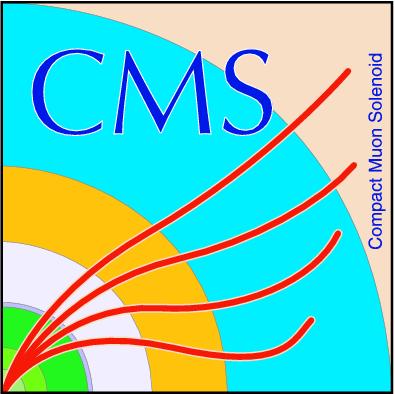
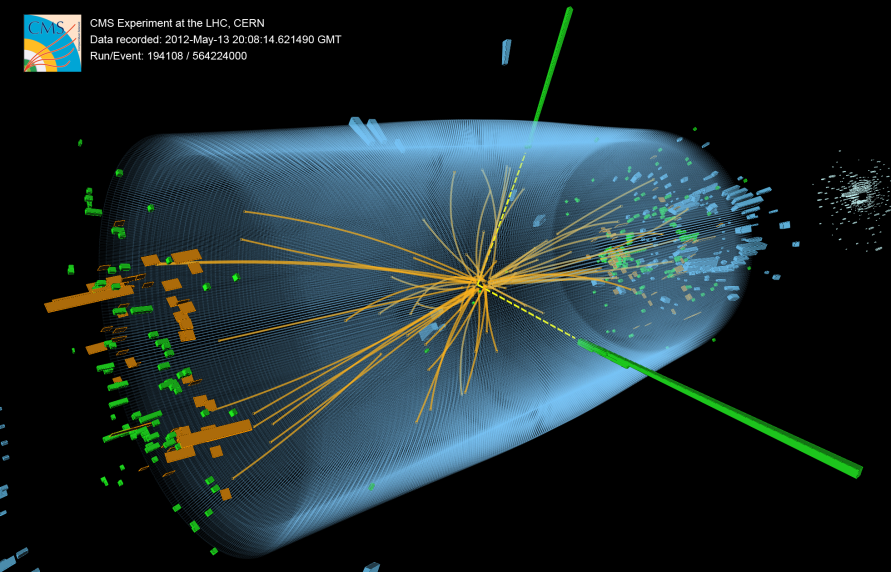
Compact Muon Solenoid
LHC, CERN
| CMS-PAS-HIG-18-003 | ||
| A search for pair production of new light bosons decaying into muons at √s= 13 TeV | ||
| CMS Collaboration | ||
| July 2018 | ||
| Abstract: This letter presents a search for new light bosons decaying into muon pairs using a data sample corresponding to an integrated luminosity of 35.9 fb−1 of proton-proton collisions at a center-of-mass energy √s= 13 TeV collected with the CMS detector at the CERN LHC. The search is model independent, only requiring the pair production of a new light boson and its subsequent decay to a pair of muons. No significant deviation is observed from the predicted background and a model independent limit is set on the product of the cross section, branching ratio, and acceptance as a function of mass. This limit varies between 0.16 fb and 0.45 fb over a range of new light boson masses from 0.25 GeV to 8.5 GeV. It is then interpreted in the context of the Next-to-Minimal Supersymmetric Standard Model and a dark supersymmetry model that allows for non-negligible light boson lifetimes. | ||
|
Links:
CDS record (PDF) ;
CADI line (restricted) ;
These preliminary results are superseded in this paper, PLB 796 (2019) 131. The superseded preliminary plots can be found here. |
||
| Figures | |

png pdf |
Figure 1:
Left: The distribution of the invariant masses m(μμ)1 vs. m(μμ)2 for the isolated dimuon systems. There are 56 events in the data (bullets) that pass all selection criteria except for the m(μμ)1≃m(μμ)2 requirement and thus fall outside the diagonal region. The diagonal signal region m(μμ)1≃m(μμ)2 (outlined with dashed lines) contains the 13 events observed in data (triangles) that pass all selection criteria. The expected SM background distribution is indicated by the color scale. Right: The 95% CL upper limit set on σ(pp→2a+X)×B2(a→2μ)×αGen over the range 0.25 <ma< 8.5 GeV. |
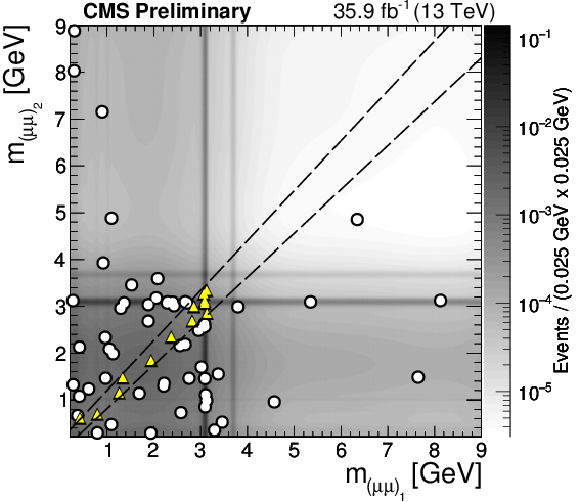
png pdf |
Figure 1-a:
Left: The distribution of the invariant masses m(μμ)1 vs. m(μμ)2 for the isolated dimuon systems. There are 56 events in the data (bullets) that pass all selection criteria except for the m(μμ)1≃m(μμ)2 requirement and thus fall outside the diagonal region. The diagonal signal region m(μμ)1≃m(μμ)2 (outlined with dashed lines) contains the 13 events observed in data (triangles) that pass all selection criteria. The expected SM background distribution is indicated by the color scale. Right: The 95% CL upper limit set on σ(pp→2a+X)×B2(a→2μ)×αGen over the range 0.25 <ma< 8.5 GeV. |
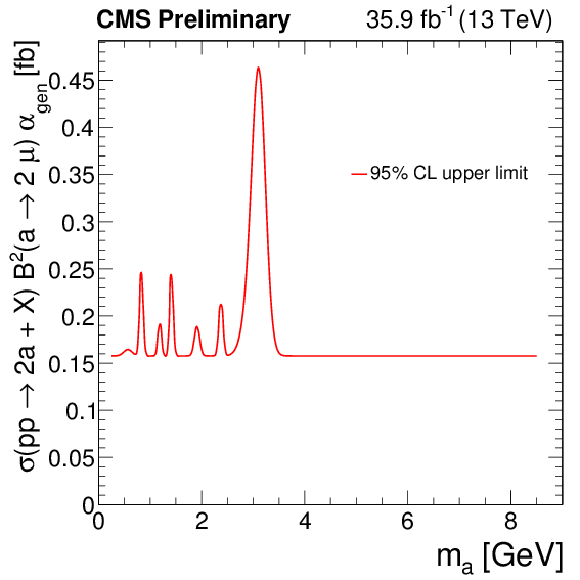
png pdf |
Figure 1-b:
Left: The distribution of the invariant masses m(μμ)1 vs. m(μμ)2 for the isolated dimuon systems. There are 56 events in the data (bullets) that pass all selection criteria except for the m(μμ)1≃m(μμ)2 requirement and thus fall outside the diagonal region. The diagonal signal region m(μμ)1≃m(μμ)2 (outlined with dashed lines) contains the 13 events observed in data (triangles) that pass all selection criteria. The expected SM background distribution is indicated by the color scale. Right: The 95% CL upper limit set on σ(pp→2a+X)×B2(a→2μ)×αGen over the range 0.25 <ma< 8.5 GeV. |

png pdf |
Figure 2:
Left: The 95% CL upper limits in the NMSSM scenario as functions of mh1 on σ(pp→h1,2→2a1)×B2(a1→2μ) with ma1= 0.25 GeV (dashed curve) and ma1= 3.55 GeV (dotted curve). The limits are compared to a representative predicted rate (solid curve) obtained using a simplified scenario where σ(pp→h1)=σSM(mh1) [60], σ(pp→h2)×B(h2→2a1)=0, B(h1→2a1)=0.3, and B(a1→2μ)=7.7. For the chosen B(a1→2μ), taken from [46], ma1= 2 GeV and NMSSM parameter tanβ=20. The figure is separated into two regions: mhi=mh1<125GeV with mh2 = 125 GeV (unshaded), and mh1 = 125 GeV with mhi=mh2>125GeV (shaded). Right: The 95% CL upper limits as functions of ma1 in the NMSSM scenario on σ(pp→h1,2→2a1)×B2(a1→2μ) with mh1= 90 GeV (dashed curve), mh1= 125 GeV (dash-dotted curve), and mh1= 150 GeV (dotted curve). These limits are compared to a representative predicted rate (solid curve) from a simplified case in which B(h1→2a1)=0.3, σ(pp→h1)=σSM(mh1=125GeV) [60], and σ(pp→h2)×B(h2→2a1)=0. Additionally, B(a1→2μ) as a function of ma1 is taken from [46] and assumes that the NMSSM parameter tanβ is 20. The simplified scenario includes gg-fusion, VBF, and VH production modes. The structures in the predicted curves arise because B(a1→gg) varies rapidly as ma1 crosses internal quark loop thresholds [46]. |
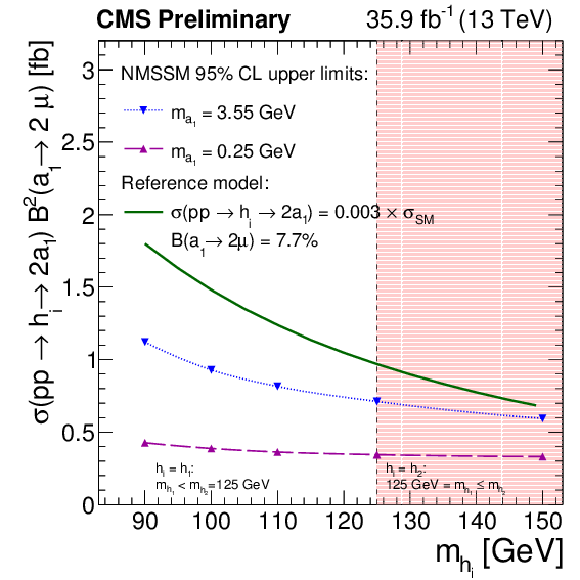
png pdf |
Figure 2-a:
Left: The 95% CL upper limits in the NMSSM scenario as functions of mh1 on σ(pp→h1,2→2a1)×B2(a1→2μ) with ma1= 0.25 GeV (dashed curve) and ma1= 3.55 GeV (dotted curve). The limits are compared to a representative predicted rate (solid curve) obtained using a simplified scenario where σ(pp→h1)=σSM(mh1) [60], σ(pp→h2)×B(h2→2a1)=0, B(h1→2a1)=0.3, and B(a1→2μ)=7.7. For the chosen B(a1→2μ), taken from [46], ma1= 2 GeV and NMSSM parameter tanβ=20. The figure is separated into two regions: mhi=mh1<125GeV with mh2 = 125 GeV (unshaded), and mh1 = 125 GeV with mhi=mh2>125GeV (shaded). Right: The 95% CL upper limits as functions of ma1 in the NMSSM scenario on σ(pp→h1,2→2a1)×B2(a1→2μ) with mh1= 90 GeV (dashed curve), mh1= 125 GeV (dash-dotted curve), and mh1= 150 GeV (dotted curve). These limits are compared to a representative predicted rate (solid curve) from a simplified case in which B(h1→2a1)=0.3, σ(pp→h1)=σSM(mh1=125GeV) [60], and σ(pp→h2)×B(h2→2a1)=0. Additionally, B(a1→2μ) as a function of ma1 is taken from [46] and assumes that the NMSSM parameter tanβ is 20. The simplified scenario includes gg-fusion, VBF, and VH production modes. The structures in the predicted curves arise because B(a1→gg) varies rapidly as ma1 crosses internal quark loop thresholds [46]. |

png pdf |
Figure 2-b:
Left: The 95% CL upper limits in the NMSSM scenario as functions of mh1 on σ(pp→h1,2→2a1)×B2(a1→2μ) with ma1= 0.25 GeV (dashed curve) and ma1= 3.55 GeV (dotted curve). The limits are compared to a representative predicted rate (solid curve) obtained using a simplified scenario where σ(pp→h1)=σSM(mh1) [60], σ(pp→h2)×B(h2→2a1)=0, B(h1→2a1)=0.3, and B(a1→2μ)=7.7. For the chosen B(a1→2μ), taken from [46], ma1= 2 GeV and NMSSM parameter tanβ=20. The figure is separated into two regions: mhi=mh1<125GeV with mh2 = 125 GeV (unshaded), and mh1 = 125 GeV with mhi=mh2>125GeV (shaded). Right: The 95% CL upper limits as functions of ma1 in the NMSSM scenario on σ(pp→h1,2→2a1)×B2(a1→2μ) with mh1= 90 GeV (dashed curve), mh1= 125 GeV (dash-dotted curve), and mh1= 150 GeV (dotted curve). These limits are compared to a representative predicted rate (solid curve) from a simplified case in which B(h1→2a1)=0.3, σ(pp→h1)=σSM(mh1=125GeV) [60], and σ(pp→h2)×B(h2→2a1)=0. Additionally, B(a1→2μ) as a function of ma1 is taken from [46] and assumes that the NMSSM parameter tanβ is 20. The simplified scenario includes gg-fusion, VBF, and VH production modes. The structures in the predicted curves arise because B(a1→gg) varies rapidly as ma1 crosses internal quark loop thresholds [46]. |

png pdf |
Figure 3:
The 90% CL upper limits (black solid curves) from this search as interpreted in the dark SUSY scenario, where σ(pp→h+X)B(h→2γD+X) with mn1= 10 GeV, mnD= 1 GeV. The limits are presented in the plane of the parameters (ε and mγD). Constraints from other experiments [21,61,62,63,64,65,66,67,68,69,70,71,72,73,74,75] showing their 90% CL exclusion contours are also shown. The colored contours for the CMS and ATLAS limits represent different values of B(h→2γD+X) that range from 0.1 to 40%. |
| Tables | |

png pdf |
Table 1:
The full reconstruction efficiency over signal acceptance ϵFull/αGen in% for several representative signal NMSSM (top) and dark SUSY benchmark models (bottom). |
| Summary |
| A search for pairs of new light bosons that subsequently decay to pairs of oppositely charged muons is presented in this Letter. This search is developed in the context of a Higgs boson decay, h→2A+X→4μ+X and is performed on a data sample collected by the CMS experiment in 2016 that corresponds to an integrated luminosity of 35.9 fb−1 proton-proton collisions with √s= 13 TeV. This dataset is larger and collected at a higher center-of-mass energy than the previous version of this search [15]. Additionally, both the mass range of the a boson and the maximum possible displacement of its decay vertex are extended compared to the previous publication of this analysis. Thirteen events are observed in the signal region, with 9.90 ± 1.24 (stat) ± 1.84 (syst) events expected from the SM backgrounds. The distribution of events in the signal region is consistent with SM expectations. A model independent 95% CL upper limit on the product of the cross section, branching fraction, and acceptance is set over the mass range 0.25 <mA< 8.5 GeV. This model independent limit is then interpreted in the context of dark SUSY with non-negligible light boson lifetime and the NMSSM. In the dark SUSY interpretation of the result, the new limit constrains previously unexamined ranges of ε and mγD. |
| References | ||||
| 1 | M. Maniatis | The next-to-minimal supersymmetric extension of the standard model reviewed | Int. J. Mod. Phys. A 25 (2010) 3505 | 0906.0777 |
| 2 | L. D. Duffy and K. van Bibber | Axions as dark matter particles | New J. Phys 11 (2009) 105008 | hep-ph/0904.3346 |
| 3 | N. Arkani-Hamed, D. P. Finkbeiner, T. R. Slatyer, and N. Weiner | A theory of dark matter | PRD 79 (2009) 015014 | 0810.0713 |
| 4 | A. Belyaev et al. | LHC discovery potential of the lightest NMSSM Higgs boson in the h1→a1a1→4μ channel | PRD 81 (2010) 075021 | hep-ph/1002.1956 |
| 5 | P. Fayet | Supergauge invariant extension of the Higgs mechanism and a model for the electron and its neutrino | NPB 90 (1975) 104 | |
| 6 | R. K. Kaul and P. Majumdar | Cancellation of quadratically divergent mass corrections in globally supersymmetric spontaneously broken gauge theories | NPB 199 (1982) 36 | |
| 7 | R. Barbieri, S. Ferrara, and C. A. Savoy | Gauge models with spontaneously broken local supersymmetry | PLB 119 (1982) 343 | |
| 8 | H. P. Nilles, M. Srednicki, and D. Wyler | Weak interaction breakdown induced by supergravity | PL120 (1983) 346 | |
| 9 | J.-M. Frere, D. R. T. Jones, and S. Raby | Fermion masses and induction of the weak scale by supergravity | NPB 222 (1983) 11 | |
| 10 | J.-P. Derendinger and C. A. Savoy | Quantum effects and SU(2)×U(1) breaking in supergravity gauge theories | NPB 237 (1984) 307 | |
| 11 | M. Drees | Supersymmetric models with extended Higgs sector | Int. J. Mod. Phys. A 4 (1989) 3635 | |
| 12 | U. Ellwanger, C. Hugonie, and A. M. Teixeira | The next-to-minimal supersymmetric standard model | PR 496 (2010) 1 | 0910.1785 |
| 13 | M. Baumgart et al. | Non-abelian dark sectors and their collider signatures | JHEP 04 (2009) 014 | 0901.0283 |
| 14 | A. Falkowski, J. T. Ruderman, T. Volansky, and J. Zupan | Hidden Higgs decaying to lepton jets | JHEP 05 (2010) 077 | 1002.2952 |
| 15 | CMS Collaboration | A search for pair production of new light bosons decaying into muons | PLB 752 (2016) 146 | CMS-HIG-13-010 1506.00424 |
| 16 | ATLAS Collaboration | Search for displaced muonic lepton jets from light Higgs boson decay in proton-proton collisions √s= 7 TeV with the ATLAS detector | PLB 721 (2013) 32 | 1210.0435 |
| 17 | CMS Collaboration | Search for light resonances decaying into pairs of muons as a signal of new physics | JHEP 07 (2011) 98 | CMS-EXO-11-013 1106.2375 |
| 18 | CMS Collaboration | Search for a very light NMSSM Higgs boson produced in decays of the 125 GeV scalar boson and decaying into τ leptons in pp collisions at √s= 8 TeV | JHEP 01 (2016) 079 | CMS-HIG-14-019 1510.06534 |
| 19 | ATLAS Collaboration | Search for new light gauge bosons in Higgs boson decays to four-lepton final states in pp collisions at √s= 8 TeV with the ATLAS detector at the LHC | PRD 92 (2015) 092001 | 1505.07645 |
| 20 | ATLAS Collaboration | Search for Higgs boson decays to beyond-the-Standard-Model light bosons in four-lepton events with the ATLAS detector at √s= 13 TeV | Submitted to \it JHEP | 1802.03388 |
| 21 | ATLAS Collaboration | Search for long-lived neutral particles decaying into lepton jets in proton--proton collisions at √s= 8 TeV with the ATLAS detector | JHEP 11 (2014) 88 | 1409.0746 |
| 22 | ATLAS Collaboration | Search for the Higgs boson produced in association with a W boson and decaying to four b-quarks via two spin-zero particles in pp collisions at 13 TeV with the ATLAS detector | EPJC 76 (2016) 605 | 1606.08391 |
| 23 | ATLAS Collaboration | Search for the Higgs boson produced in association with a vector boson and decaying into two spin-zero particles in the H→aa→4b channel in pp collisions at √s= 13 TeV with the ATLAS detector | Submitted to \it JHEP | 1806.07355 |
| 24 | ATLAS Collaboration | Search for new phenomena in events with at least three photons collected in pp collisions at √s= 8 TeV with the ATLAS detector | EPJC 76 (2016) 210 | 1509.05051 |
| 25 | CMS Collaboration | Search for the exotic decay of the Higgs boson to a pair of light pseudoscalars in the final state with two b quarks and two τ leptons | Submitted to \it PLB | CMS-HIG-17-024 1805.10191 |
| 26 | CMS Collaboration | Search for the exotic decay of the Higgs boson to a pair of light pseudoscalars in the final state of two muons and two τ leptons at √s= 13 TeV | Submitted to \it JHEP | CMS-HIG-17-029 1805.04865 |
| 27 | LHCb Collaboration | Search for Higgs-like bosons decaying into long-lived exotic particles | The EPJC 76 (2016) 664 | 1609.03124 |
| 28 | CMS Collaboration | Search for a non-standard-model Higgs boson decaying to a pair of new light bosons in four-muon final states | PLB 726 (2013) 564 | CMS-EXO-12-012 1210.7619 |
| 29 | CMS Collaboration | Performance of the CMS muon detector and muon reconstruction with proton-proton collisions at √s= 13 TeV | Submitted to \it JINST | CMS-MUO-16-001 1804.04528 |
| 30 | CMS Collaboration | Performance of CMS muon reconstruction in pp collision events at √s= 7 TeV | JINST 7 (2012) P10002 | CMS-MUO-10-004 1206.4071 |
| 31 | CMS Collaboration | The CMS trigger system | JINST 12 (2017) P01020 | CMS-TRG-12-001 1609.02366 |
| 32 | CMS Collaboration | The CMS experiment at the CERN LHC | JINST 3 (2008) S08004 | CMS-00-001 |
| 33 | CMS Collaboration | Particle-flow reconstruction and global event description with the CMS detector | JINST 12 (2017) P10003 | CMS-PRF-14-001 1706.04965 |
| 34 | W. Adam, B. Mangano, T. Speer, and T. Todorov | Track reconstruction in the CMS tracker | CMS-NOTE-2006-041 | |
| 35 | NNPDF Collaboration | Parton distributions with QED corrections | NPB 877 (2013) 290--320 | 1308.0598 |
| 36 | T. Sjostrand et al. | An introduction to PYTHIA 8.2 | Computer Physics Communications 191 (2015) 159 | 1410.3012 |
| 37 | P. Skands, S. Carrazza, and J. Rojo | Tuning PYTHIA 8.1: the Monash 2013 tune | EPJC 74 (2014) 3024 | 1404.5630 |
| 38 | WMAP Collaboration | Nine-year Wilkinson microwave anisotropy probe (WMAP) observations: Cosmological parameter results | Astrophys. J. Suppl. 208 (2013) 19 | 1212.5226 |
| 39 | Planck Collaboration | Planck 2013 results. XVI. Cosmological parameters | Astron. Astrophys. 571 (2014) A16 | 1303.5076 |
| 40 | OPAL Collaboration | Decay mode independent searches for new scalar bosons with the OPAL detector at LEP | EPJC 27 (2003) 311 | hep-ex/0206022 |
| 41 | OPAL Collaboration | Search for a low mass CP-odd Higgs boson in e+e− collisions with the OPAL detector at LEP-2 | EPJC 27 (2003) 483 | hep-ex/0209068 |
| 42 | ALEPH, DELPHI, L3, OPAL, LEP Working Group for Higgs Boson Searches Collaboration | Search for neutral MSSM Higgs bosons at LEP | EPJC 47 (2006) 547 | hep-ex/0602042 |
| 43 | OPAL Collaboration | Search for neutral Higgs boson in CP-conserving and CP-violating MSSM scenarios | EPJC 37 (2004) 49 | hep-ex/0406057 |
| 44 | DELPHI Collaboration | Searches for neutral Higgs bosons in extended models | EPJC 38 (2004) 1 | hep-ex/0410017 |
| 45 | ALEPH Collaboration | Search for neutral Higgs bosons decaying into four taus at LEP2 | JHEP 05 (2010) 049 | 1003.0705 |
| 46 | R. Dermisek and J. F. Gunion | New constraints on a light CP-odd Higgs boson and related NMSSM ideal Higgs scenarios | PRD 81 (2010) 075003 | 1002.1971 |
| 47 | J. Alwall et al. | MadGraph/MadEvent v4: the new web generation | JHEP 09 (2007) 028 | 0706.2334 |
| 48 | P. Meade and M. Reece | BRIDGE: Branching ratio inquiry / decay generated events | hep-ph/0703031 | |
| 49 | GEANT4 Collaboration | GEANT4---a simulation toolkit | NIMA 506 (2003) 250 | |
| 50 | CMS Collaboration | Search for supersymmetry in pp collisions at √s= 13 TeV in the single-lepton final state using the sum of masses of large-radius jets | JHEP 08 (2016) 122 | 1605.04608v2 |
| 51 | T. Sjostrand, S. Mrenna, and P. Z. Skands | A brief introduction to PYTHIA 8.1 | CPC 178 (2008) 852 | 0710.3820 |
| 52 | M. Bahr et al. | Herwig++ physics and manual | EPJC 58 (2008) 639 | 0803.0883 |
| 53 | A. Belyaev, N. D. Christensen, and A. Pukhov | CalcHEP 3.4 for collider physics within and beyond the standard model | CPC 184 (2013) 1729 | 1207.6082 |
| 54 | CMS Collaboration | CMS luminosity measurements for the 2016 data taking period | CMS-PAS-LUM-17-001 | CMS-PAS-LUM-17-001 |
| 55 | M. Botje et al. | The PDF4LHC working group interim recommendations | 1101.0538 | |
| 56 | S. Alekhin et al. | The PDF4LHC working group interim report | 1101.0536 | |
| 57 | R. D. Ball et al. | Parton distributions with LHC data | NPB 867 (2013) 244 | 1207.1303 |
| 58 | J. Butterworth et al. | PDF4LHC recommendations for LHC Run II | JPG: Nucl. Part. Phys. 43 (2016) 023001 | 1510.03865v2 |
| 59 | J. M. Campbell and R. Ellis | Loops and legs in quantum field theory MCFM for the Tevatron and the LHC | NPB Proc. Suppl. 205 (2010) 10 | 1007.3492v1 |
| 60 | LHC Higgs Cross Section Working Group Collaboration | Handbook of LHC Higgs cross sections: 1. inclusive observables | 1101.0593 | |
| 61 | PHENIX Collaboration | Search for dark photons from neutral meson decays in p+p and d+Au collisions at √sNN= 200 GeV | PRC 91 (2015) 031901 | 1409.0851 |
| 62 | KLOE-2 Collaboration | Search for light vector boson production in e+e−→μ+μ−γ interactions with the KLOE experiment | PLB 736 (2014) 459 | 1404.7772 |
| 63 | APEX Collaboration | Search for a new gauge boson in electron-nucleus fixed-target scattering by the APEX Experiment | PRL 107 (2011) 191804 | 1108.2750 |
| 64 | A. Adare et al. | Search at the Mainz Microtron for light massive gauge bosons relevant for the muon g-2 anomaly | PRL 112 (2014) 221802 | 1404.5502 |
| 65 | HADES Collaboration | Searching a dark photon with HADES | PLB 731 (2014) 265 | 1311.0216 |
| 66 | BaBar Collaboration | Search for a dark photon in e+e- collisions at BABAR | PRL 113 (2014) 201801 | 1406.2980 |
| 67 | A. Fradette, M. Pospelov, J. Pradler, and A. Ritz | Cosmological constraints on very dark photons | PRD 90 (2014) 035022 | 1407.0993 |
| 68 | R. Essig et al. | Working group report: New light weakly coupled particles | 1311.0029 | |
| 69 | L. M. K. James B. Dent, Francesc Ferrer | Constraints on light hidden sector gauge bosons from supernova cooling | 1201.2683 | |
| 70 | H. K. Dreiner, J. Fortin, and L. U. C. Hanhart | Supernova constraints on MeV dark sectors from e+ e- annihilations | PRD 89 (2014) 105015 | 1310.3826 |
| 71 | J. B. J. Blumlein | New exclusion limits for dark gauge forces from beam-dump data | PLB 701 (2011) 155 | 1104.2747 |
| 72 | R. Essig, R. Harnik, J. Kaplan, and N. Toro | Discovering new light states at neutrino experiments | PRD 82 (2010) 113008 | 1008.0636 |
| 73 | A. R. Brian Batell, Maxim Pospelov | Exploring portals to a hidden sector through fixed targets | PRD 80 (2009) 095024 | 0906.5614 |
| 74 | S. N. Gninenko | Constraints on sub-GeV hidden sector gauge bosons from a search for heavy neutrino decays | PLB 713 (2012) 244 | 1204.3583 |
| 75 | LHCb Collaboration | Search for dark photons produced in 13 TeV pp collisions | PRL 120 (2018) 061801 | 1710.02867 |
| 76 | B. Batell, M. Pospelov, and A. Ritz | Probing a secluded U(1) at B-factories | PRD 79 (2009) 115008 | 0903.0363 |

|
Compact Muon Solenoid LHC, CERN |

|
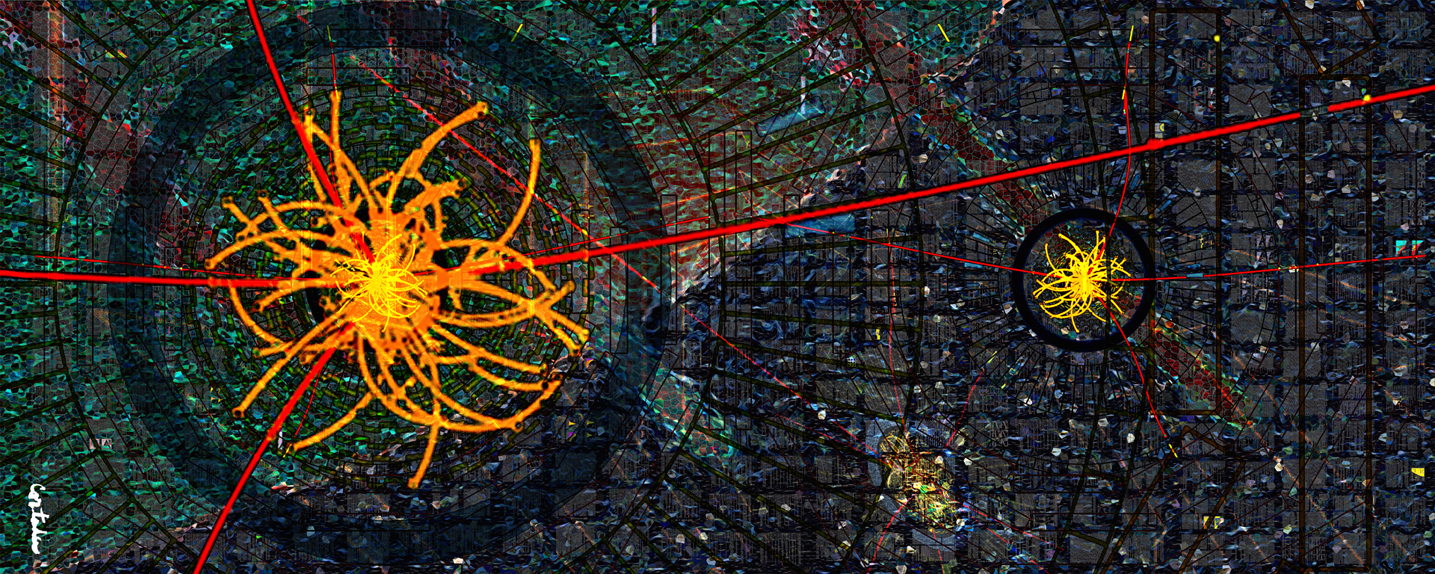
|
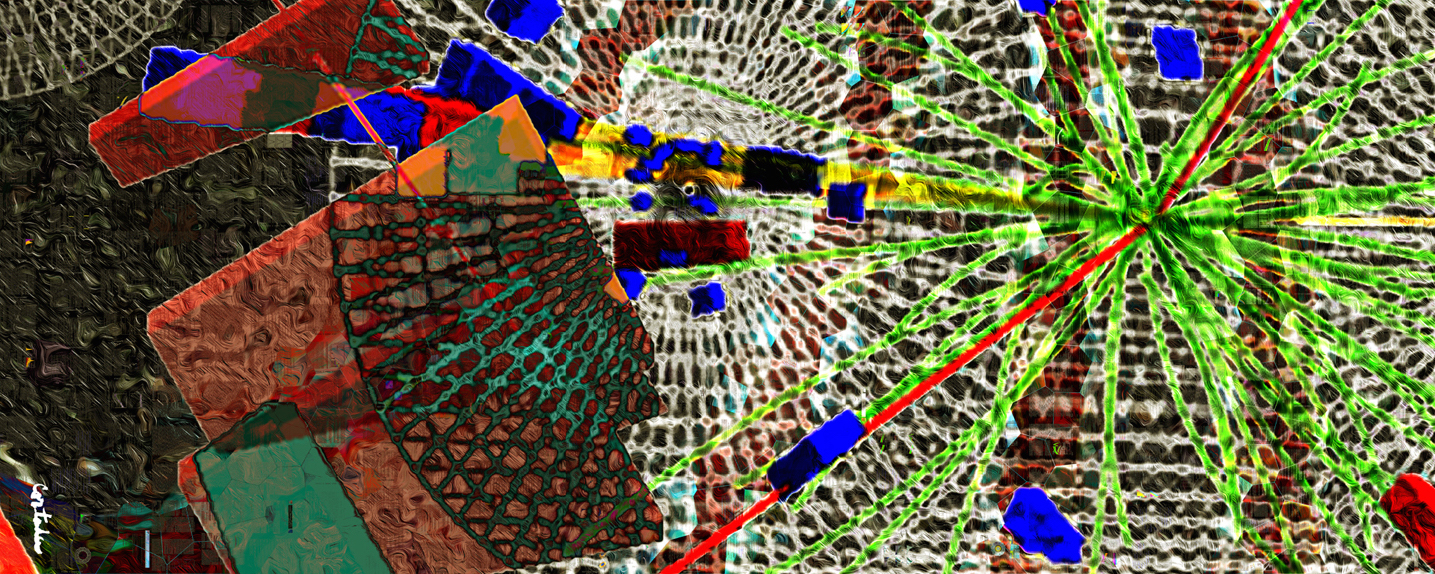
|

|
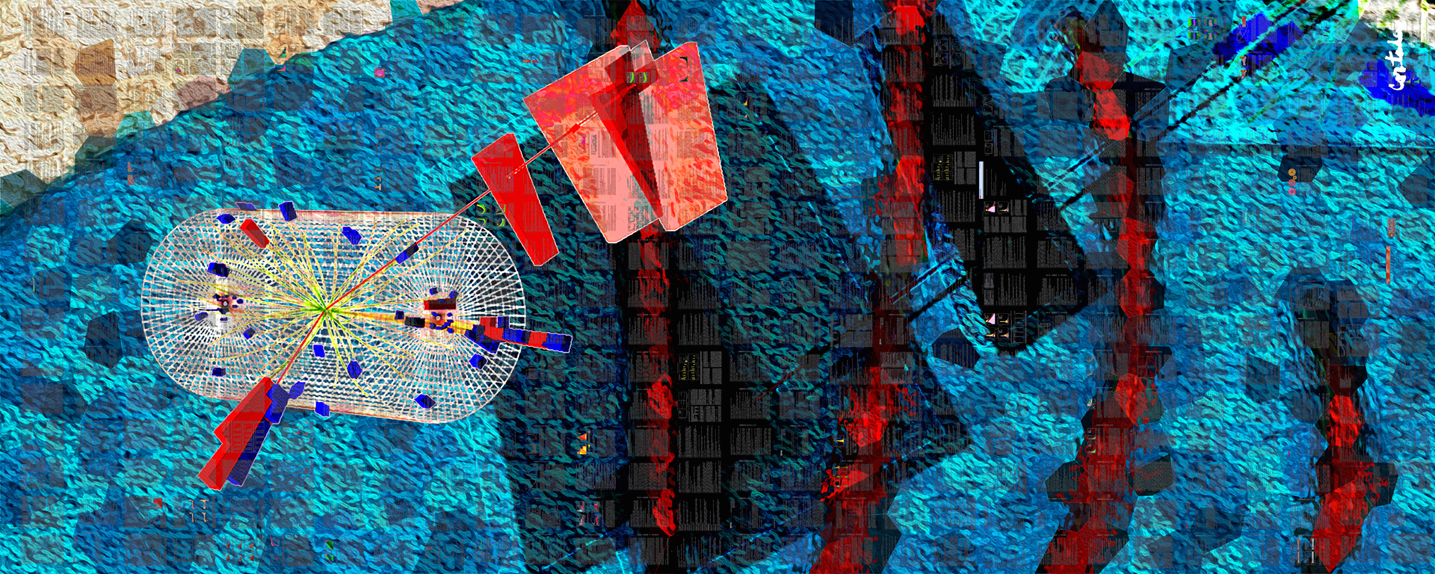
|
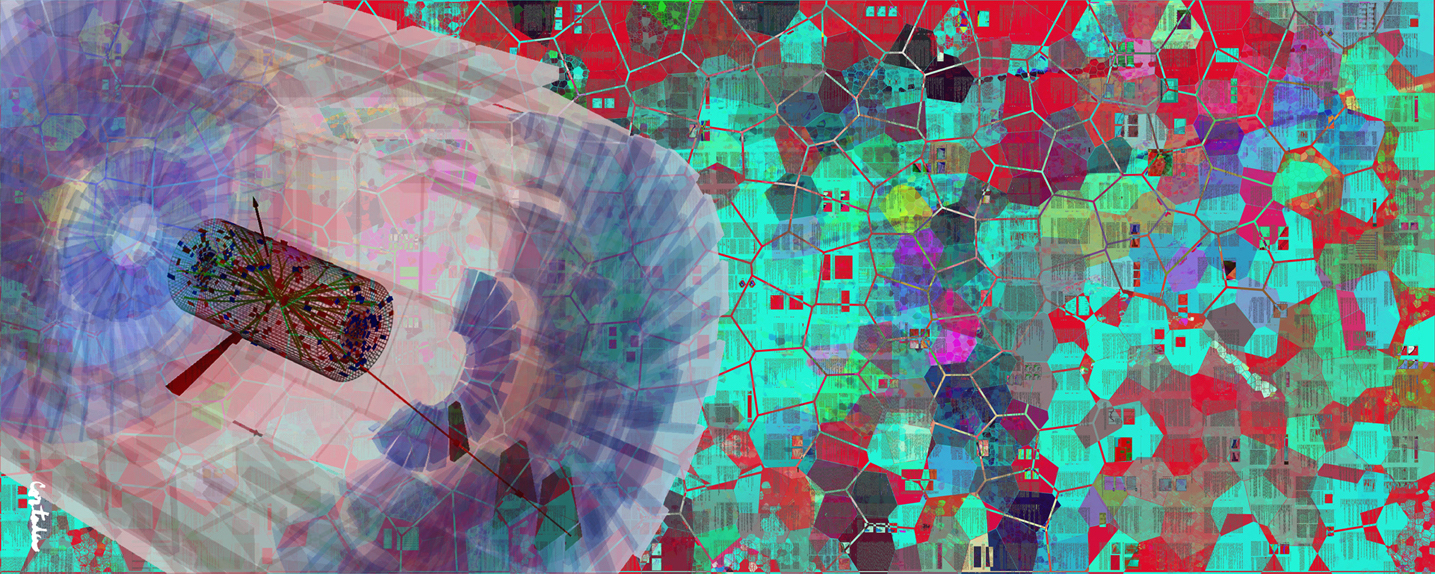
|